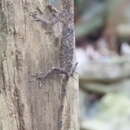tr
kırıntılardaki isimler


Draco timoriensis, the Timor flying lizard, is one of about 40 species in its genus, all of which are known for their ability to glide long distances, using membranes supported by elongated thoracic ribs.It is found in the Lesser Sundra Islands of Indonesia.Draco timoriensis has been considered a synonym of D. volans (Inger 1983) and as a subspecies of D. volans (Musters 1983), but was revised as a distinct species by McGuire and Kiew (2001).This study recognizes it as a distinct species due to the fact that it is geographically distinct from D. volans and morphologically distinguished an enlarged series of keeled paravertebral scales and distinct color patterns. The Timor flying lizard is sexually dichromatic: males having a bright yellow patagia (membranes used for flight).The pigmentation of the patagia on females, on the other hand, varies between populations on different islands.Females have dark black and brown ventral and dorsal surfaces on Timor, Roti and Semau whereas on Alor and Wetar the ventral patagia have little or no pigment.Based on this and other substantial intraspecific variation among D. timoriensis populations on these islands, which separated by deep-water channels McGuire and Kiew (2001) suggest that D. timoriensis may in fact include several distinct species.
Draco timoriensis, the Timor flying lizard, is one of about 40 species in its genus, all of which are known for their ability to glide long distances, using membranes supported by elongated thoracic ribs.It is found in the Lesser Sundra Islands of Indonesia.Draco timoriensis has been considered a synonym of D. volans (Inger 1983) and as a subspecies of D. volans (Musters 1983), but was revised as a distinct species by McGuire and Kiew (2001).This study recognizes it as a distinct species due to the fact that it is geographically distinct from D. volans and morphologically distinguished an enlarged series of keeled paravertebral scales and distinct color patterns. The Timor flying lizard is sexually dichromatic: males having a bright yellow patagia (membranes used for flight).The pigmentation of the patagia on females, on the other hand, varies between populations on different islands.Females have dark black and brown ventral and dorsal surfaces on Timor, Roti and Semau whereas on Alor and Wetar the ventral patagia have little or no pigment.Based on this and other substantial intraspecific variation among D. timoriensis populations on these islands, which separated by deep-water channels McGuire and Kiew (2001) suggest that D. timoriensis may in fact include several distinct species.
Draco timoriensis, the Timor flying lizard, is one of about 40 species in its genus, all of which are known for their ability to glide long distances, using membranes supported by elongated thoracic ribs.It is found in the Lesser Sundra Islands of Indonesia.Draco timoriensis has been considered a synonym of D. volans (Inger 1983) and as a subspecies of D. volans (Musters 1983), but was revised as a distinct species by McGuire and Kiew (2001).This study recognizes it as a distinct species due to the fact that it is geographically distinct from D. volans and morphologically distinguished an enlarged series of keeled paravertebral scales and distinct color patterns. The Timor flying lizard is sexually dichromatic: males having a bright yellow patagia (membranes used for flight).The pigmentation of the patagia on females, on the other hand, varies between populations on different islands.Females have dark black and brown ventral and dorsal surfaces on Timor, Roti and Semau whereas on Alor and Wetar the ventral patagia have little or no pigment.Based on this and other substantial intraspecific variation among D. timoriensis populations on these islands, which separated by deep-water channels McGuire and Kiew (2001) suggest that D. timoriensis may in fact include several distinct species.